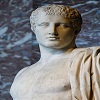The signs of the Greek Zodiac

The signs of the Greek Zodiac
In ancient Greece, the signs of the greek zodiac were identified with twelve groups of stars (constellations) which we can see in the night sky at different times during the year.
They were also associated with one of the four elements - Earth, Air, Fire and Water - and behind each one of them lies a fascinating story. As a matter of fact, the word itself, "zodiac", comes from a greek word meaning "the circle of animals" - "animals" referring to all living creatures. And indeed,with the exception of Libra, each one of the myths is associated with living beings, either animals or humans.
Starting with Aries (the ram) in spring and following the year around through summer, fall and winter to Pisces (the fishes), the stories of the greek zodiac's twelve signs explain how each group of stars found its way into the heavens.
On the image above, you can see the star formations of the twelve signs in a circle. Click on each one of them to go to the relevant section on the page and read its story.
The signs of the Greek Zodiac
Aries (March 21 - April 20)
Aries is the first sign of the greek zodiac, marking the beginning of spring and the start of a new cycle of life.
The story of Aries is linked with the myth of the Golden Ram, which saved two kids, a brother and a sister, from being sacrificed in order to appease the gods.
Once Jason had completed his mission, Zeus put the ram's golden fleece up in the skies, where it appears till today as the constellation of Aries.
Taurus (April 21 - May 21)
The next sign of the greek zodiac is the constellation of Taurus (bull), associated with the legend of Theseus and the Minotaur.
According to myth, Theseus volunteered to be one of the youths from Athens who would be offered as food to the horrible monster Minotaur (half man, half bull) who stayed in Crete, in the labyrinth. But, when he was there and with the help of Ariadne, the legendary hero managed to kill the beast and thus relieve his city Athens from the terrible punishment imposed by the Cretan king Minos.
Gemini (May 22 - June 21)
The constellation of Gemini is the next sign of the greek zodiac. It is linked with the story of the twin brothers Castor and Polydeuces (Pollux in latin). Actually, they were not twins in the ordinary sense, since they had different fathers.
Their story starts when Zeus, king of the gods, wanted to have an affair with Leda, the lovely queen of Sparta. In order to fool her, he transformed himself into a beautiful swan.
In the course of time, Leda bore two eggs: One of them contained a baby girl named Helen (the same one who later was the cause of the Trojan War) and a boy boy called Pollux. These two were the divine children of Zeus.
The other egg opened up to reveal another girl and boy, Clytemnestra (who later became the wife of Agamemenon, the military leader of the Greeks in the Trojan War) and Castor. These were the mortal children of king Tyndareus, the legitimate husband of Leda.
Despite the fact that one brother was divine and the other mortal, the twins Castor and Pollux grew to be inseparable. They did everything together and they loved each other dearly.
Because they were so close, they were called by one name; the Dioscuri. As they were growing, they both loved all kinds of sport. Pollux was particularly good at boxing, while Castor was renowned for his skill and daring on horseback.
When Jason was recruiting the Argonauts to join him in his quest of the Golden Fleece, the Dioscuri eagerly accepted the invitation.
During the expedition, they became famous for their ability to calm the rough seas, which once or twice had threatened to capsize the Argo.Poseidon, the god of the seas, had made the twin brothers joint saviors of shipwrecked sailors and granted them the power to send favorable winds whenever they wished.
Even to this day, the sight of the stars of the Dioscuri in the sky is regarded by sailors as an omen of good luck.
Unfortunately, following a bitter fight that the twins had with other warriors, Castor was killed and was summoned to the Underworld.
Pollux was heartbroken and prayed to almighty Zeus to take his life as well, for he would not bear to live without his brother.
When Zeus invited to join him and the rest of the Olympians on Olympus, Pollux declined saying that he would not like to live forever, while his beloved brother was dead.
Zeus was so touched by the twin's love and affection for his brother, that he arranged for them to be together again. They could divide their time between the heavens and the Underworld, spending one day high up in Olympus and the next day beneath the earth, in the realm of Hades.
In further recognition of their brotherly love, he set their images among the stars as the constellation of Gemini, so that they would never be again separated. They stand out as two equally bright stars in a constellation of weaker stars.
Cancer (June 22 - July 23)
The constellation of the greek zodiac known as Cancer (Crab), is linked with the second labor of the mighty hero Hercules, when he was assigned by Eurystheus to kill Lerna Hydra, a horrible water snake with a hundred heads.
As the story goes, in the midst of Hercules' struggle, Hera, who was the hero's worst enemy, ordered a giant crab to go and help the Hydra by digging its claws into Hercules' foot.
Howling with pain, the hero stamped on the crab furiously, crushing it to death.
Hera, being grateful for its support and in recognition of its attempt to help her, honored the crab by placing its image among the stars, as the constellation of Cancer.
Leo (July 24 - August 23)
Leo, the fifth constellation of the greek zodiac, is linked with Hercules' very first labor, the capture of the Nemean Lion.
According to the myth, Hercules finally managed to kill the beast by strangling it to death. Then, he skinned the lion and took its pelt to wear it. He was then quite protected from his enemies, as the skin could not be penetrated from any known weapon of the time whether made of iron, bronze or stone.
After its death, the famous lion was put on the sky by Zeus, to become the constellation of Leo.
Virgo (August 24 - September 23)
The constellation of Virgo (the maiden based on Astraea) is associated with the story of Demeter and her daughter Persephone.
For the ancient Greeks, the story of Demeter and Persephone helped to explain why the seasons change.
Libra (September 24 - October 23)
The stars that form the golden scales of Libra lie halfway around the band of the greek zodiac, between Virgo and Scorpio.
Day and night are equal when the sun passes through the constellation of Libra. The scales are a symbol of balance and equity.
More specifically, the scales were considered to be the symbol of Dike (was one of the three Charites (or Graces), daughter of Zeus and Themis), meaning Justice, who was a minor goddess of the Underworld.
The fact that the ancient greeks gave Libra a prominent place in the sky, signifies that they considered justice, equity and balance in general, to be the moral cornerstones of an ideal way of living.
Scorpio (October 24 - November 22)
The eighth constellation of the greek zodiac is the one with the name Scorpio. The story of the scorpion is connected with different versions of stories that involve the mighty hunter Orion - a hero who is represented by another familiar group of stars.
Orion was said to be the tallest and the most handsome man of the then known world. He was often seen hunting in the woods and hills of ancient Greece with his pack of dogs. His constellation shows him striding across the heavens flourishing a gleaming sword on his bejeweled belt.
Many of the stories concerning the constellations of Orion and Scorpio reflect the annual rising and setting of their constellations, which appear to pursue each other across the sky.
One story tells how Gaia had sent the scorpion to sting Orion, in order to punish him for being too boastful, claiming that he was so mighty that he could easily rid the whole earth of all beasts and creatures.
As soon as the scorpion was released from the breast of Gaia, it immediately stung Orion and its deadly venom sent him straight to his death.
The scorpion was set up on the sky by Gaia to mark her victory, while goddess Artemis, who had loved Orion, placed his image on the sky as well, forming his own constellation. Because Orion had cared so much for his hunting dog, Artemis also put up a star for his dog: This is Sirius, the brightest star in the heavens.
There is another story about Orion and the scorpion.
One day, when Orion was out in the woods, he caught sight of seven beautiful sisters, the daughters of Atlas and Pleione. Orion loved them all at first sight and began to chase after them.
The sisters, however, were terrified and cried out to Zeus to save them.
Zeus heard their pleas and helped them by turning them first into doves, so they could fly away from Orion, and then into the seven stars which are now called Pleiades.
According to myth, Orion was stung by the scorpion as a punishment for chasing the seven sisters. Zeus decided that the constellations of Orion and the Pleiades were arranged in the heavens, so that it seemed that Orion was in constant pursuit of the seven sisters, without ever becoming successful, just as the Scorpio seems always to be chasing Orion, without ever touching him.
Sagittarius (November 23 - December 21)
The constellation of Sagittarius (the archer),depicts a creature called centaur, which has the body and head of a man and the hindquarters of a horse.
He is named after Cheiron, the most famous and king of the centaurs. He was semi-divine, as he was the son of god Poseidon. He was taught by god Apollo and goddess Artemis, and from them he learned both wisdom and spirituality.
He dwelt in a cave high up in the rocky, snowy sides of Mount Pelion. He was the oldest and wisest of all the centaurs and very strong. In fact, he was so famous, that many kings had trusted their sons to teach them. Among the most famous of his students were Hercules, and Jason, who later became the leader of the argonauts.
As the myth goes, Cheiron was destined to suffer a gruesome death: When Hercules was returning home to Tiryns after killing the Erymanthian Boar, he had a violent encounter with some drunken centaurs, which he managed to drive away near the place where Cheiron lived.
By accident, however, one of the poisonous arrows that Hercules used to defend himself from his attackers, went astray and hit his old teacher. Cheiron, being semi-divine, would not die, having to suffer an excrutiating pain, because of the poison.
He was in such an agony, that Zeus himself felt sorry for the poor centaur and permitted him to give up his divine status and give it to Prometheus, the creator of the human race. So, Cheiron finally was let to die, relieved from the intolerable pain that was inflicted on him from the wound.
Capricorn (December 22 - January 20)
The constellation of the greek zodiac by the name of Capricorn, is as strange as that of Sagittarius. It is a sea god, with the head and half the body of a goat, and the tail of a fish.
The story of Capricorn is associated with the birth of Zeus, the father of all gods.
As the story goes, when Rhea gave birth to baby Zeus, she feared that her cruel husband Cronus would devour her child, just as he did with the previous ones that she gave birth to.
So, she secretly took her child to Crete, where he was safely kept in a cave on Mount Dicte. There, he was nursed and cared for by Amaltheia, whose name means "tender". She was a goat nymph, and she looked after baby Zeus with the greatest love and devotion, feeding him on her own rich milk and sweet lavender-scented honey.
Zeus's golden cradle was hung high upon a tree so that Cronus would never find him in Heaven or Earth, or even in the ocean.
When Zeus later became the lord of the universe, he did not forget his goat-mother, Amaltheia, who had nursed him so lovingly. He took one of her horns and turned it into the horn of plenty, which is always filled with whatever delicious food or drink its owner may wish for, and is never empty.
Finally, in recognition of all she had done for him, she set her image among the rest of stars on the greek zodiac, as the constellation of Capricorn.
Aquarius (January 21 - February 19)
The constellation of Aquarius shows a person pouring water out of a jug. It is thought that the story behind this group of stars is that of Ganymede.
Ganymede was the son of king Tros, after whom Troy was named. The young prince was the most exquisite and handsome youth that ever lived, and was adored and admired by both gods and mortals.
Zeus, who was especially fond of beautiful people, was totally infatuated with Ganymedes's external appearance. Thinking it would be appropriate for so handsome a mortal as Ganymede to live with the gods, the mighty god disguised himself as an enormous eagle. He then flew down to Earth, captured the handsome youth and brought him up to Olympus.
Up there on the heavenly palace, Zeus had to find a job for his young protegee. So, he decided that Ganymede should be given the special honor of being his personal cupbearer.
The position was considered to be highly distinguished, since the person who was assigned the duty of the cupbearer, was responsible for pouring into the glasses of the olympians the divine drink called nectar. This was the special drink that bestowed on the gods their eternal youth and vigor.
Zeus was forever fond of his cupbearer. So, he honored him by giving him a prominent position on the greek zodiac, as the constellation of Aquarius.
Pisces (February 20 - March 20)
The image of the two fish swimming in different directions make the constellation of Pisces.Aphrodite, the goddess of love and beauty, was thought to be the source of inspiration for this particular constellation being set in the stars.
After Zeus had fought his father, Cronus, he defeated the race of the giants, who were the children of Gaia, the mother earth.
In revenge for the destruction of her children, Gaia gave birth to a horrible monster, called Typhon. He was the largest and most frighening creature ever born. From the thighs down he was a mass of coiled snakes, while his arms were so long that when he spread them out he reached a hundred leagues each way.
Let loose by his mother Gaia, Typhon thundered towards the Olympian home of the gods, declaring war on all of them. The gods hurried to disguise themselves, in the hope that the horrible creature would not find them:
Zeus took the image of a ram; Hera, became a white cow;Artemis became a cat;Hermes turned into an ibis, while Ares became a wild boar.
Lastly, the goddess Aphrodite and her son Eros, dived deep into the ocean and took the shape of twin fish.
When the fierce monster was finally captured by Zeus and all of the olympians were transformed back to their original form, Aphrodite, being grateful to the fish who had lended their form to her and her son when they were in distress, put up their image on the night sky. Thus, Pisces became the last constellation of the greek zodiac.
[1]
Milky Way
There is a certain circular figure among the constellations, white in color, which some have called the Milky Way. Eratosthenes says that Juno, without realizing it, gave milk to the infant Mercury, but when she learned that he was the son of Maia, she thrust him away, and the whiteness of the flowing milk appears among the constellations.
Others have said that Hercules was given to Juno to nurse when she slept. When she awoke, it happened as described above. Others, again, say that Hercules was so greedy that he couldn’t hold in his mouth all the milk he had sucked, and the Milky Way spilled over from his mouth.
Still others say that at the time Ops brought to Saturn the stone, pretending it was a child, he bade her offer milk to it; when she pressed her breast, the milk that was caused to flow formed the circle which we mentioned above.
[2]











